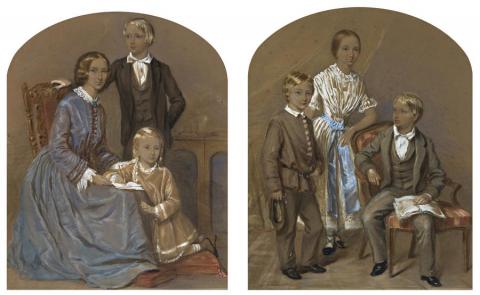A PAIR OF PORTRAITS OF THE FAMILY OF THOMAS AND MARY BURBURY, OATLANDS, TASMANIA, c.1845
Attributed To THOMAS BOCK
watercolour and crayon on paper
75.0 x 65.0 cm each (sight)
(I) PORTRAIT OF MARY BURBURY WITH HER CHILDREN DANIEL (B.1834) AND MARY (B.1839), OATLANDS, TASMANIA, c1845
(II) PORTRAIT OF CAROLINE (B.1830), WILLIAM (B.1836) AND HENRY (B.1838), OATLANDS, TASMANIA, c1845
Thomas and Mary Burbury, Oatlands, Tasmania
Thence by descent
Estate of Reginald Burbury, Tasmania
Private collection, Tasmania
Hidden Treasures of Launceston, Academy Gallery, University of Tasmania, Launceston, 16 March – 27 April 2012, cats. 3 and 4 (as Thomas Bock)
The prominent Tasmanian family of Burbury, which numbers Sir Stanley Burbury the first locally born Governor among its members, had its antipodean beginnings at the Warwick Assizes of March 1832. It was here that Thomas Burbury, husband of Mary and father of the children in these two family portraits, was sentenced to death for his Luddite role in the burning down of Beck's steam factory at Coventry. Saved by the intervention of the M.P. for Coventry, Edward Ellice, Thomas was sentenced to transportation for life, arriving in Hobart Town in December 1832. Through reports of excellence and positions of responsibility, Burbury rose from service as a constable in the town of Oatlands to district constable, being given a free pardon in October 1839. As his wife Mary and baby daughter Caroline had come to Hobart in early 1833, Thomas acquired land at Oatlands in her name, building a house and 'offices for his butchery'.1 Considerable land was acquired elsewhere including 'the Race Course Marsh near Oatlands on which he ran his herds'.2 By 1852 Burbury was clerk of the Oatlands Race Course. Among the first elected to the Oatlands council in 1862, his entry in the Australian Dictionary of Biography records - 'For thirty-eight years Burbury has taken part in every public movement in the district and was a member of every public body, commanding general esteem and confidence.'3
The two group portraits of Mrs Mary Burbury and her children present relaxed images of domestic content based on colonial success. The first shows Mary in flowing blue dress with her children Daniel (born 1834) and younger sister Mary (born 1839). The companion piece is of Caroline, the eldest (born 1830), with brothers William (1836) and Henry (1838). Their formal poses speak of the elegance and refinement of a past age, the images richly evocative of the time. The commissioned artist Thomas Bock was one of the leading colonial portrait painters of his day. Bock, like Thomas Burbury, was a convict, having arrived in Van Diemen's Land in 1824, some eight years before Burbury. Again, exemplary conduct led to a free pardon - in 1832. Acknowledged for having introduced engraving into the colony, Bock cut the plates for the Bank of Van Diemen's Land banknotes. Living in Hobart Town, he soon established a reputation for portraiture, including many of the colony's notables among his clientele. Although he painted some portraits in oil, Bock preferred watercolour and crayon, later extending his business to include photography, in daguerreotype. Through his numerous portraits of considerable artistic quality, Bock has given us works rich in personal fascination and historic interest.
1. Rude, G., 'Burbury, Thomas', Australian Dictionary of Biography, Melbourne University Press, 1996 edition, vol. 1, p. 179. Biographical information is based on this entry.
2. Ibid.
3. Ibid.
DAVID THOMAS
